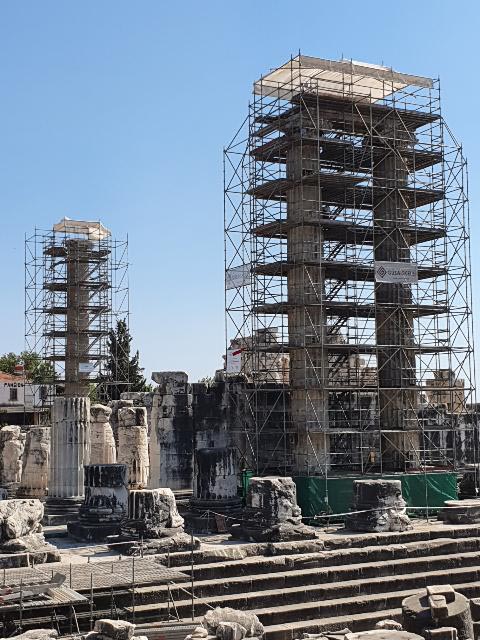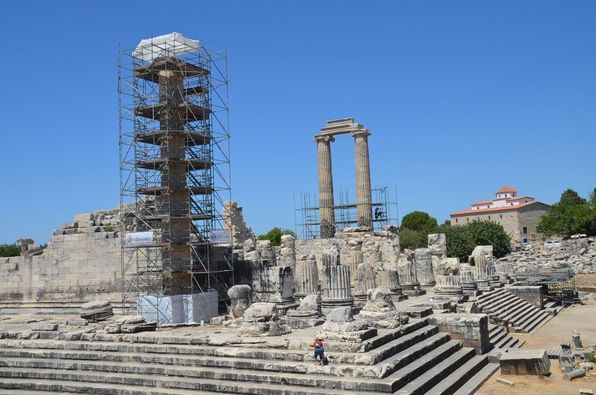Another week another jaunt to the Temple to observe how the archaeologists are progressing with the much-required maintenance of Didyma’s inspiring columns, writes Glenn Maffia.
Indignity of the new
We are now fast approaching the halfway stage along the two-month timescale set by the Director of Excavations and the action appears to have increased exponentially as the days have flowed by.
As the targeted areas are quite specific there really is no need to have a multitude of bodies clambering upon the scaffolding, just those whom are necessary will suffice. Therefore, though it may not appear particularly full of activity the job in hand is moving apace.

I watched attentively as a large plastic bottle of water was hoisted to the summit of the double columns which was then liberally splashed upon the ancient stones; “They are filling the cracks and crevices with concrete”, hurriedly crossed my mind. For some reason I felt a little despondent these ancient stones were being subjected to the indignity of being maintained by 21st century materials. It seemed to devalue their very spirit. Or so I imagined from a distance.
Skilled artisan
I haven’t had this confirmed as yet, but one image suggests to me the archaeologists are not using industrial mixed concrete but one that is being produced on-site using the very same system employed by the Greeks and Romans. That would be much more in keeping with the uniqueness and ambiance of the site.
As I was departing the Temple precinct I noticed a rather weathered Turkish man sitting in the shade of a laurel tree, farmer’s-style cap perched upon his head, crushing some stone most meticulously.
I could identify the stone as limestone or marble (marble is referred to as metamorphosed limestone in geology, but in stonemasonry it can and does encompass un-metamorphosed limestone).
Obviously the gentleman is most skilled at his craft as he reduced the stone into a gritty-like dust. This then would be added to an aggregate, usually of sand, with water then mixed thoroughly and later applied to a surface. I could not ascertain where the mixing was taking place as quite a portion of the site is roped off for obvious safety concerns.
Virtual visualisation
Though it is possible the archaeologists are using modern concrete due to the extremely narrow window of opportunity afforded by the timescale and that this skilled artisan’s activity is merely but an experimental exercise. This, to me, suggests the obvious question, how far into the future shall this maintenance prevail? 20 years? 50 years?
Nothing lasts for an eternity, least of all concrete; all shall fade and crumble, though should we not have the diligence to preserve the dignity of ancient craftsmen and the creations of their fertile minds?
If only the archaeologists working at the Didyma site were more publicly vocal in their aims and aspirations we may well have a far greater appreciation of the work they achieve.
I am afraid that far too much ‘archaeological’ tinkering in this country utilising modern materials devalues ancient sites into little more than a Disneyworld experience, one that is ideal for photo opportunities for the mass tourism visitors and sadly laughable to the cultural branch of tourism.
After all, we do have the technology today to present a 3D computer-generated imaging system which would allow those with no imagination to visualise an ancient site virtually.
